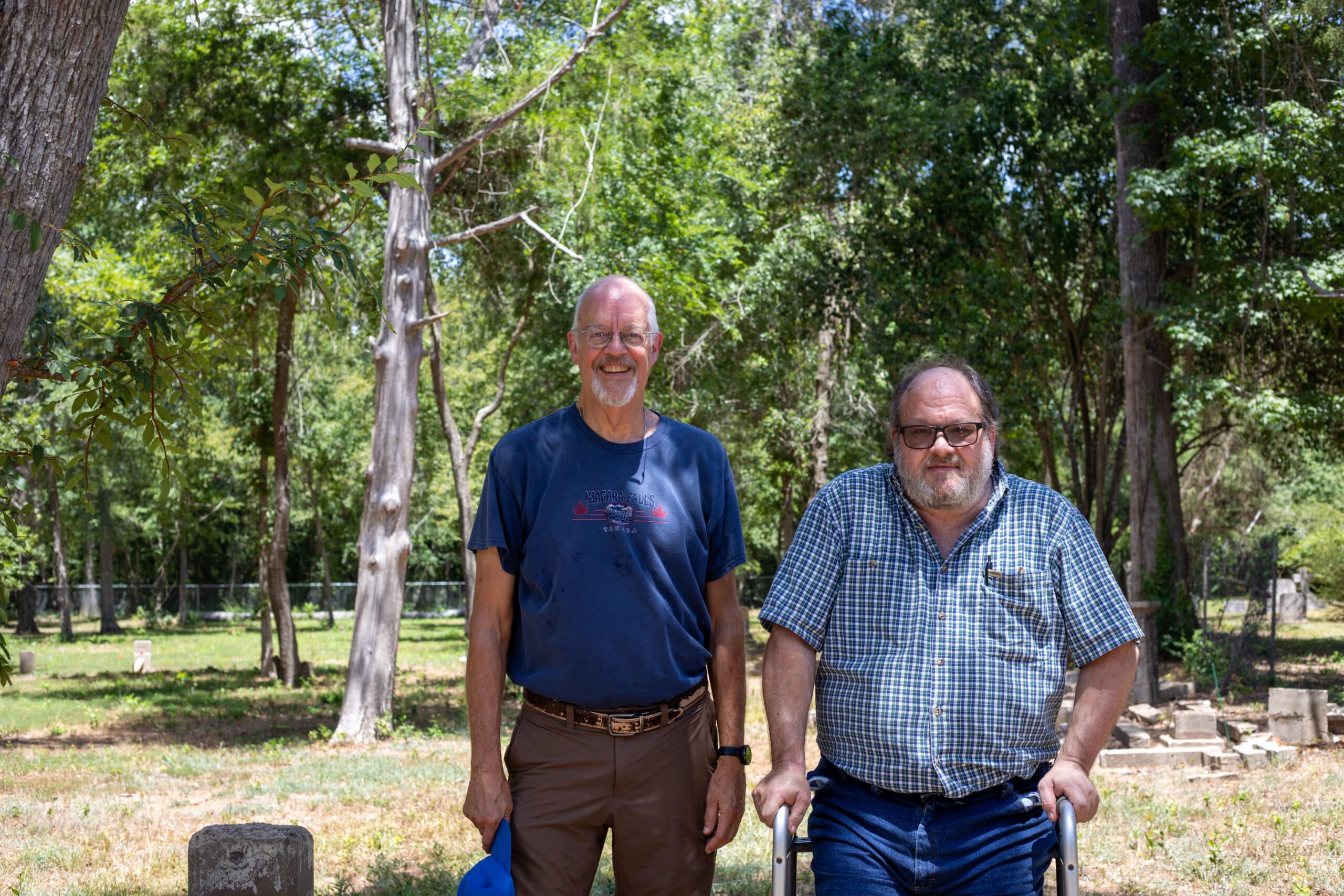
James Pitts III has childhood memories of clearing around his grandfather’s and other family members’ graves at a cemetery in Conroe in the 1970s, pouring salt around them to discourage plant growth. He doesn’t remember his grandfather, James Pitts Sr., who died when James was a toddler, but his parents told him many stories about his remarkable life. Born just 11 years after slavery ended in Texas, he was the valedictorian of his class at Prairie View State Normal & Industrial College (now Prairie View A&M University). In 1901, he moved from Conroe to teach at the African-American high school in Jefferson, Texas. Overwhelmed by the educational deficiencies caused by slavery, he became the school’s principal and ultimately served there for 60 years. He began each school day with Bible reading, a prayer and a song, and added vocational classes to the school’s curriculum. He was also a landowner and a respected entrepreneur.
After graduating from Texas A&M University in 1988, James Pitts III lived in Austin, and often came to Houston to visit his sister and to work at the cemetery. “I’d get there on Friday night, get up really early, and take a bunch of tools to Conroe,” he says. He was appalled that trash and automobile parts had been dumped at the cemetery. He later moved to Georgia, but brought his wife and children to Conroe in 2005 to show them where his ancestors were buried. Passersby were surprised when he told them there was a cemetery hidden beneath the underbrush. James wondered, “Why are my ancestors overgrown, with trash on top of them?”
In the summer of 2011, Jon Edens, a forensic genealogist, walked slowly through Oakwood Cemetery. As he zigzagged through the graves, he transcribed information from headstones for his contributing work for Find a Grave, an organization that compiles burial information at cemeteries worldwide. Nearing the cemetery’s northern border, Jon glanced through the chain-link fence into the impenetrable tangle of trees, thorns and underbrush beyond.
Jon was stunned when he saw what looked like a headstone. Why, he wondered, would it be on the other side of the fence? He climbed over and discovered the ornate grave monument of Dora Armstrong, who died in 1918. Then, he saw another headstone, and another. When he returned home, he told his wife Terri, “You’ll never believe what I found!” He later remarked that, if a smaller headstone had been near the fence, he would not have seen it.
Jon then began a research project that would last for five years. Meticulous and tenacious, he enjoys reading laws–so he knew that graves located outside a cemetery boundary are legally a part of that cemetery. But something didn’t seem right. So, he researched the name on the large headstone he had discovered. The first piece of the puzzle fell into place when he learned that Dora Armstrong was of African-American heritage. Then, while conducting research at the Montgomery County Central Library, he found an April 7, 1978 survey of “Un-Known Name Cemetery” conducted by Oveta and Horace Wright. The survey listed seven unknown and 36 known graves. Some of the names were on headstones Jon had identified across the fence from Oakwood Cemetery.
“That’s when it snapped that this was a whole different cemetery,” Jon says. At some point, he deduced the rest of the story: the “Un-Known Name Cemetery” was used exclusively by Conroe’s African-American community. “It took a little while to figure it out,” he says. “It’s not mentioned in the county record.”
While poring over microfilm of decades-old issues of the Conroe Courier, Jon found a 1982 article that mentioned a cleanup day at the cemetery. It reported that the property was owned by the descendants of Sergeant Luther Dorsey, who is buried at the cemetery. Dorsey, who served in the U.S. Army’s 10th Cavalry Regiment, is the only known Buffalo Soldier buried in Montgomery County.
It bothered Jon that the cemetery had been so neglected, and he wanted to mount a restoration effort; however, he soon learned there was a controversy surrounding the ownership of the cemetery land. Through Jon’s persistence, it finally became certain that 19th century land baron Henry Runge sold adjacent land to Laura Henderson—who is interred in the cemetery—but specifically excluded eight acres for a railroad and the cemetery. Because Runge died without a will, wife or descendants, the property legally belongs to the descendants of his siblings.
To get permission to restore the cemetery, Jon began locating these heirs, and more than 30 of them subsequently gave their approval. Meanwhile, Jon began calling the unnamed cemetery the “Conroe Community Cemetery,” noting that the people buried there were an important part of their community; furthermore, the modern-day community has come to the cemetery’s rescue. He formed a 501(c)(3) organization, calling it Conroe Community Cemetery Restoration Project (CCCRP).
In the years after Jon stumbled upon the cemetery, he talked often with Larry Foerster, a local attorney, historian, author, and the chairman of the Montgomery County Historical Commission. “Larry provided constant support,” Jon says. In 2016, as Jon was forming a non-profit organization and workforce, Larry emailed John Meredith, a retired petroleum geologist and native Houstonian. Larry surmised correctly that John would be interested in being a part of a meaningful project close to home. John, a member of both The Sons of the Republic of Texas and Sons of the American Revolution, agreed to become one of the members of CCCRP’s Board of Directors.
John soon began helping Jon Edens complete the non-profit’s articles of incorporation and bylaws, and started formulating a master plan for the cemetery’s cleanup. One of the first things he did was to ask his friend Lanny Dreesen, who holds a degree in forestry, to visit the overgrown cemetery and catalogue the plants. “At some point, I started reading about black burial practices,” he says, learning that plants were often transplanted near graves.
Nine volunteers attended the CCCRP’s first work day on September 3, 2019. Work was agonizingly slow–for fear of disturbing graves and archaeological evidence, only hand tools were used. As workdays continued and more volunteers participated, additional headstones were discovered, some covered beneath soil or broken by tree roots. One had a tree growing through the headstone. Volunteers also found numerous rusted steel markers which once contained information about the deceased written on paper and covered with glass. Regrettably, time and nature have obliterated the names on all but three. Many burial objects—like seashells, broken pieces of pottery and ornate glassware—were found. Soon, workers learned that almost every time they found a gardenia plant, there was a grave nearby. “There started to be this relationship that came out with that particular plant,” John says.
With the motto of “Do no harm,” the dense undergrowth was carefully removed over the next three years. Several techniques were used to locate graves, including cadaver dogs, ground penetrating radar, and metal detectors. In addition, John studied the soil survey of the area so he could identify lower ground layers sitting on the surface—evidence that a grave had been dug. He also used a two-foot probe to feel for burial objects. “Once you do it enough, you get a feel whether it’s glass, a root or a headstone,” John says. He also learned that shallow depressions often indicated the presence of a grave.
Although several graves mentioned on the Wright survey have not yet been located, seven graves not mentioned on the survey have been found. By 2019, volunteers had found only 24 marked and 17 unmarked graves, but the CCCRP now suspects there are about 200 graves dating back to the 1800s. “There are 47 where we know at least the initials of the person–another 150 where we may never know who that person is,” John says.
With financial help from the Montgomery County Historical Commission, “unknown grave” markers have been erected. Headstones are being restored. Some are broken; others are mostly illegible. Legible headstones, however, have prompted research about the individuals interred in the cemetery. In some cases, descendants of those people have been contacted, including James Pitts III, who is thrilled by the CCCRP’s efforts. “I really appreciate what they’ve done,” he says.
John notes that many influential people were buried in the cemetery, including community activists and three esteemed educators: Mittie Turner Campbell was the founder and principal of the first African-American public school in Conroe; Jacob Cozier was a pastor and teacher; the State of Texas recognized James Pitts Sr. as the leading African-American educator in Texas in 1942.
In 2011, most locals had no idea there was an overgrown cemetery on North 10th Street, but the cemetery now has a fence and a sign for the first time in 128 years, and all three and a half acres have been cleared. “I get goosebumps thinking about it,” Jon Edens says.
“Both our County Historical Commission and the Texas Historical Commission are thrilled by the good work done by Jon Edens, John Meredith, and the committed volunteers serving on the CCCRP,” Larry says. (The Montgomery County Historical Commission recognized Jon Edens and John Meredith for distinguished service in 2020.) In 2021, Conroe Community Cemetery was designated a Texas Historic Cemetery by the Texas Historic Commission, and Larry promises the cemetery will one day receive a Texas Historic Marker. “It is inspiring to see people of all ages, races, and cultural backgrounds come together to restore the old cemetery,” he says.
Volunteers seem to find fulfilment in the task. After spending countless hours working alongside diverse people, John Meredith values the friendships he has made. “When you get out there and talk to people face to face, you find how much we have in common,” he says. “There is more that unites us than divides us.”
For more information, visit cccrp.org

Postcards Magazine
936-293-1188
PO Box 690
Huntsville, TX 77342
